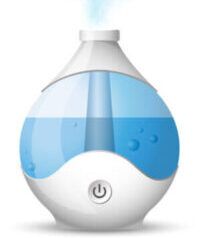
When should you turn on a humidifier to hydrate your skin?
Each year people in the USA conduct Internet searches for the term “humidifier”. These searches are seasonal in nature and coincide with the drying trends in the weather that impact indoor air. Internet searches for “humidifier” are also seasonally correlated with searches for “dry skin”, which makes sense because people use humidifiers to deal with dry skin and other conditions related to dry indoor air.
Depending on your situation, you can decide to turn on your humidifier when:
- you start experiencing dry skin,
- the indoor heating season starts in early fall,
- the relative humidity is below a target range of 40 to 60%, or
- the Dry Skin Index exceeds 6.
Humidifier use trigger: dry-skin symptoms
One option for deciding when to set up your room or portable humidifier is the condition of your skin. Specifically, does your skin exhibit drying symptoms such as dandruff, flakes, itchiness, or roughness? As a first course of action, it may actually be easier to apply a skin moisturizer to dry areas of your skin instead of running a humidifier. However, as indoor air gradually becomes drier into the fall, moisturizer therapy alone may not completely alleviate your symptoms. In this situation, consider using a humidifier in your bedroom when you sleep. This is a reasonable “first-use” of a humidifier. Nevertheless, if dry-skin conditions persist, a room humidifier together with the selective application of moisturizing lotions and creams constitutes a flexible treatment strategy.
Humidifier use trigger: start of heating season
If you don’t want to wait for dry-skin symptoms to develop before using a humidifier, then an easy-to-remember trigger is the start of the heating season. The cooler outdoor air that prompts the use of indoor heating also contains lower levels of water vapor. As the cool, dry air enters a warmer residence the relative humidity drops because the warm air can hold a lot more water vapor. Lower indoor temperatures and humidities put increased drying stresses on skin–causing seasonal dry skin.
For many parts of the USA, October marks the beginning of the heating season, which makes it a good month to get your humidifier ready and to check whether you have moisturizers ready for use too.
Humidifier use trigger: target relative humidity
Research has shown that the optimum relative humidity for healthy skin is about 60%. As the relative humidity decreases below that level, your skin begins to dehydrate, and therefore the need for remedial rehydration measures increases, including the application of moisturizers to impacted skin and/or the operation of a room humidifier.
There is no standard “trigger” level of relative humidity for starting up a humidifier, but 40% RH seems to be a good default level–and here’s why. Relative humidities just below 60% are probably best handled by simply applying a moisturizer to the areas of your skin that are prone to dryness. Below 40% RH, the extra hydration provided by a humidifier can help ameliorate the external drying stresses over your entire skin surface.
Humidifier use trigger: Dry Skin Index above 6
An alternative “trigger” is to consider a room humidifier when the Dry Skin Index (DSI) exceeds a value of 6. The risk of dry-skin formation generally starts when the DSI level is between 4 and 5, depending on how a person’s skin responds to drying stresses. Also, older people are likely to be more susceptible to dry skin formation due to biochemical changes in the skin’s barrier function with age. At moderate levels of the DSI, skin moisturizers are usually the most convenient way of keeping skin hydrated, but at high levels (DSI 6 +), a room humidifier becomes a useful tool in keeping your skin hydrated. If you work from home, you have more flexibility to use a humidifier in selected rooms that you use.
Humidifier triggers: some pros and cons
The “best” trigger for you is the one that is most likely to get you to start up a humidifier! Perhaps the most “persuasive” trigger is the development of dry-skin symptoms. However, waiting for symptoms to occur delays the timely treatment of skin dehydration.
Alternatively, the start of the heating season can serve as a reminder that the time is at hand to start up a humidifier—prior to the manifestation of dry-skin symptoms. If that trigger proves problematic (will you really remember to get the humidifier out?), then monitoring indoor relative humidity constitutes another option. Nevertheless, one pitfall here is that inexpensive humidity sensors can give inaccurate readings of relative humidity, which means that you could be basing your skin-care decisions on erroneous information.
Ultimately, your awareness of the relationship between seasonal drying stresses on your skin and effective treatment options–including a room humidifier, constitutes the best motivational “trigger” for pursuing timely skin care.
